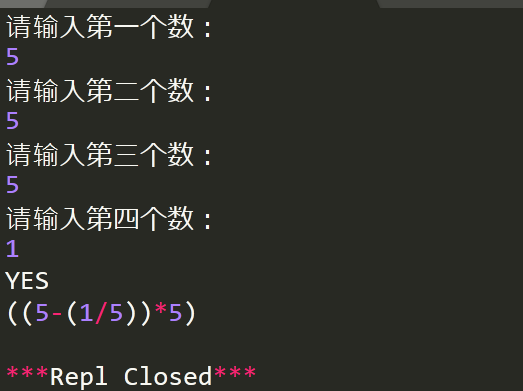一、算24
描述:
给出4个小于10的正整数,可以使用加、减、乘、除4种运算以及括号把4个数连接起来得到一个表达式。现在问题是,是否存在一种方式使得所得表达式的结果等于24。
这里加、减、乘、除以及括号的运算结果和运算优先级跟平常定义一致。
例如,对于5,5,5,1,可知5×(5-1/5)=24。又如,对于1,1,4,2无论如何都不能得到24
代码:
from itertools import permutations n1 = input("请输入第一个数: ") n2 = input("请输入第二个数: ") n3 = input("请输入第三个数: ") n4 = input("请输入第四个数: ") n = n1+n2+n3+n4 sum = 1 for i in n: sum *= eval(i) if sum < 24: print("NO") exit() notation = ['+', '-', '*', "/"] st = set() num = 0 number = set(permutations(n))#将n进行相应的排列组合 for i in notation: s = i t1 = notation.copy() t1.remove(i)#进行一次就去掉一个运算符 for j in t1: s += j t2 = t1.copy() t2.remove(j) for p in t2: s += p st.add(s) s = i+j s = i newst = set() for i in number: for j in st: newst.add(i[0]+j[0]+i[1]+j[1]+i[2]+j[2]+i[3]) # print(newst) all = set() for i in newst: i1 = '('+i[0:3]+')'+i[3:] i2 = i[0:2]+'('+i[2:5]+')'+i[5:] i3 = i[0:4] + '(' + i[4:] + ')' i4 = '(('+i[0:3]+')'+i[3:5]+")"+i[5:] i5 = i[0:2]+'(('+i[2:5]+')'+i[5:]+")" i6 = '(' + i[0:2] + '(' + i[2:5] + '))' + i[5:] i7 = i[0:2]+'('+i[2:4]+'('+i[4:]+"))" all.add(i1) all.add(i2) all.add(i3) all.add(i4) all.add(i5) all.add(i6) all.add(i7) result = [] for i in all: try: if eval(i) == 24: result.append(i) except: pass print("YES") print("("+sorted(result)[0]+")")
运行结果:

二、Collatz猜想
描述:
Collatz猜想也叫3n+1猜想,给一个正整数,如果是偶数,则减半;如果是奇数,则变为它的三倍加一。直到变为1停止。猜想对于所有正整数经过足够多次变换最终达到1。
代码:
m=int(input("输入一个整数:")) while m!=1: if m%2==0: m=m/2; print('%.1f' %m) else: m=(3*m+1); print('%.1f' %m)
运行结果:

三、二分法求平方根
描述:
设计一个用二分法计算一个大于或等于 1 的实数 n 的平方根的函数sqrt_binary(n),计算精度控制在计算结果的平方与输入的误差不大于1e-6。
代码:
import math def sqrt_biary(n): low=0 #设置下限为0 high=max(n,1) #设置上限为n和1之中的最大数,即:如果n>=1,那么上限为n;如果n<1,那么上限为1 guess=(low+high)/2 #先从中间值开始猜 count=1 #设置猜测次数起始值为1 while abs(guess**2-n)>(1e-6) and count<100: #当猜测值的平方和n本身的差值无限接近误差值时,循环才会停止;同时设置猜测次数不超过100次 if guess**2<n: #如果猜测值的平方小于n,那么将此设为下限 low=guess else: #如果猜测值的平方大于n,那么将此设为上限 high=guess guess=(low+high)/2 #根据新的上下限,重新进行猜测 count+=1 #猜测次数每次增加1 print(guess) m=float(input("请输入需要计算的数:")) print("二分法运算结果:") sqrt_biary(m) print("库函数运算结果: ",math.sqrt(m))
运行结果:
